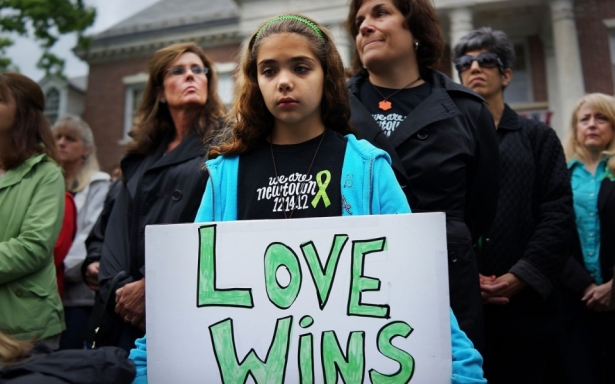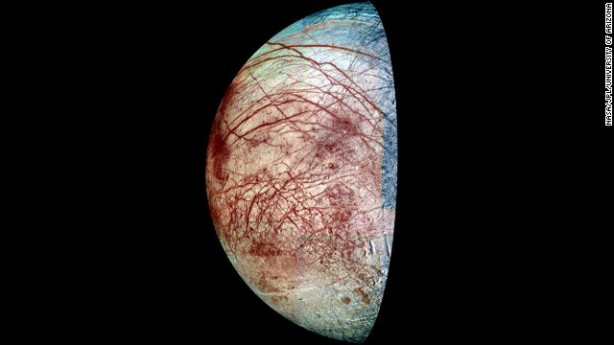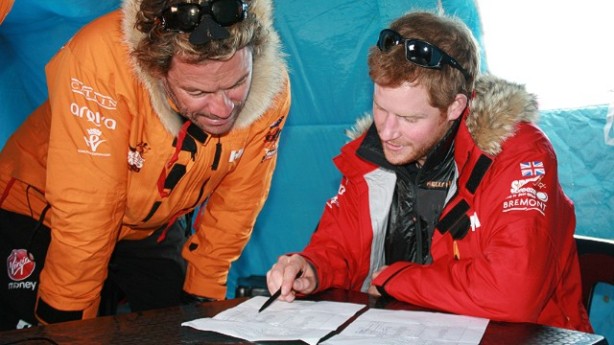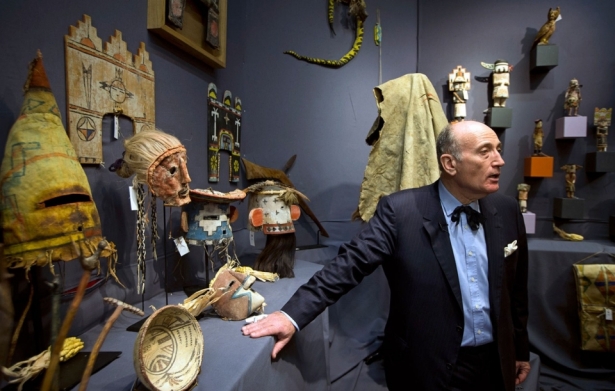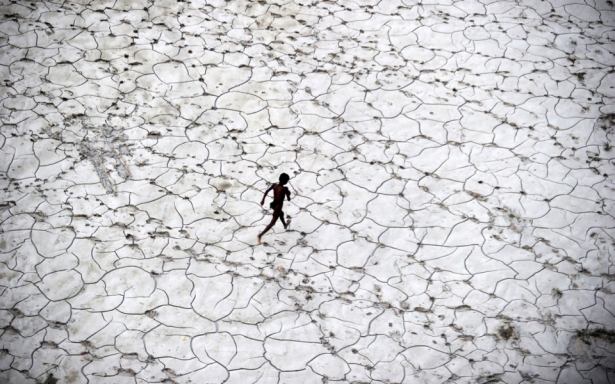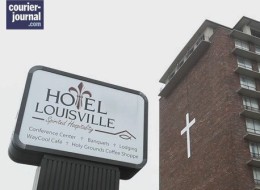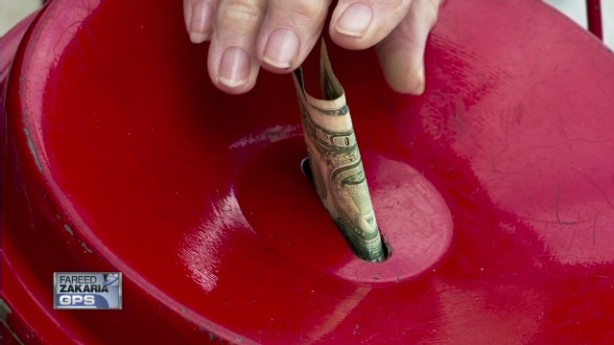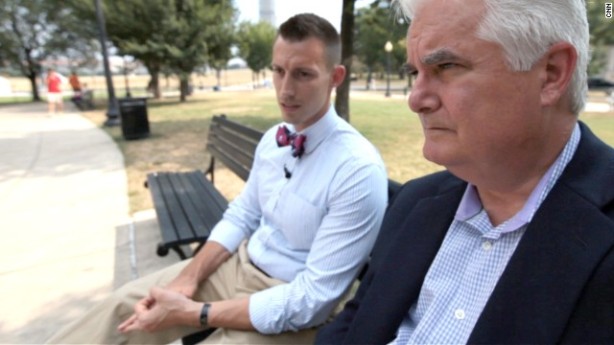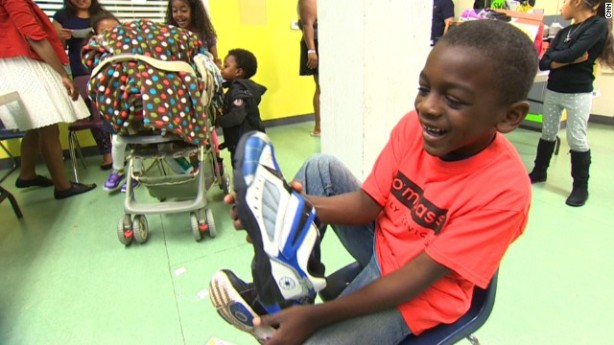During times of adversity and doubt, it is easy for people to lose faith in goodness, in the power of a random act of kindness. Often in these trying times we build and congregate around memorials, places common to us where we can feel safe within our community. There is no such memorial in Sandy Hook. Instead, in a place in such desperate need of solace, the community has asked its members to reach out, becoming through acts of giving and helping a living memorial to the courage and resilience exhibited on the day of the terrible tragedy. Instead of coming to some hallowed ground to share thoughts and emotions, residents have been sharing their goodwill by helping their neighbors, with anything from paying for someone’s coffee to organizing toy giveaways. This is how Sandy Hook is healing itself in the wake of unspeakable horror, and displaying for all the world the triumph of goodness and love over fear and doubt.
Author: thefataloptimist
Scientists Find New Source of Liquid Water on Jupiter’s Moon
Astronomers often pronounce the search for extraterrestrial life and the search for liquid water on foreign planets and moons to be one and the same. The circumstances, they posit, that allow water to maintain its liquid state are very similar to those conditions necessary to sustain life, even if only at the most simple levels. Astronomers have long known that Jupiter’s Moon, Europa, was composed of ice, and some even suggested that there might be liquid water beneath that ice. To study this water would be a dream for planetary scientists, but the complexities of drilling through the ice were insurmountable. Now, it appears, nature may have the solution: astronomers now believe that Europa ejects some of its water through cracks in the ice, expelling it as vapor. This finding has excited the imaginations of researchers, who believe this is the key to recovering and analyzing the water beneath Europa’s ice.
http://www.cnn.com/2013/12/13/tech/jupiter-moon-water/index.html?hpt=hp_t3
Snow System Heads for the Northeast
The recent bout of cold weather is about to get worse for much of the Northeast, according to meteorologists. A cold system is currently on a path to bring snowfall to much of the east coast, from Washington, which could see up to an inch of snow, to Pennsylvania and New York State which could see anything up to ten inches of snow in areas. Metropolitan areas won’t be spared, either. New York City could see four to six inches of snow, and Boston can expect an inch or two more. South of Washington, the storm is expected to bring heavy rains. Weather experts warn that there is even more snow on the way.
http://www.cnn.com/2013/12/13/us/winter-weather/index.html?hpt=hp_t2
Prince Harry Treks to the South Pole for Charity
In December 1911, a Norwegian expedition became the first humans to set foot on the South Pole. Almost one hundred and two years later to the day, Prince Harry of England and his expedition achieved the same feat in order to promote his charity Walking with the Wounded. The Prince and his team had to endure subzero temperatures during their more than two hundred mile journey to the Earth’s most southern spot, all in a name of the cause most dear to him: helping wounded veterans. Harry previously attempted to reach the North Pole in 2011, but had to turn back before his goal because of the royal wedding.
http://www.cnn.com/2013/12/13/world/south-pole-trek-harry/index.html?hpt=hp_t2
US Charity buys American Indian Masks at Auction to Return Them
One often hears of priceless cultural artifacts being sold away to the highest bidder at auctions, and of the conversion of these historical treasures into the mantelpieces of opulent homes. This was the fate consigned to the two dozen Hopi and Apache Masks being sold this week at auction in Paris, despite myriad efforts by international organizations to block their sale. Coming to the rescue was the Annenberg Foundation, which snatched up the masks at a cost of more than half a million dollars. While the foundation stressed that this was a singular act of preservation under duress that it doesn’t necessarily wish to repeat, it was of principle importance that these sacred works be returned to their rightful owners.
Underground Water Supply Seen as Panacea for Global Water Crisis
A massive supply of freshwater has been discovered beneath the sea floor on continental shelves around the world, a finding that could provide a new solution to a looming global water crisis according to a report published last week.
“Knowing about these reserves is great news because this volume of water could sustain some regions for decades,” lead author Dr. Vincent Post said according to a release. Post is a researcher for Australia’s National Centre for Groundwater Research and Training (NCGRT) and a lecturer at the School of Environment at Flinders University in Australia.
“Freshwater on our planet is increasingly under stress and strain so the discovery of significant new stores off the coast is very exciting. It means that more options can be considered to help reduce the impact of droughts and continental water shortages.”
Water scarcity affects almost half of the world’s population, and scientists predict that by 2030 47 percent of the population will be living in areas of high water stress, according to U.N. Water, an inter-agency of the United Nations that supports states in water-related efforts.
According to U.N. Water, humans are also over-consuming natural resources, including water, at an unsustainable rate. About 3.5 Earths would be needed to supply water to a global population consuming at the rates of the average European or North American.
The Flinders University study, published Dec. 5 in the international scientific journal Nature, said there is an estimated half million cubic kilometers (nearly 120,000 cubic miles) of low-salinity water buried under the seabed.
The water could be used to supplement water supplies of coastal cities in Australia, China, North America, and South Africa.
“The volume of this water resource is a hundred times greater than the amount we’ve extracted from the Earth’s sub-surface in the past century since 1900,” Post said, adding that while scientists knew freshwater could be found under the sea floor, they believed it was rare.
Now, Post said their research shows that “fresh and brackish aquifers below the seabed are actually quite a common phenomenon.”
Undersea water reserves were formed over hundreds of thousands of years when the sea level was much lower than it is today, and the coastlines were further out. When it rained, the water would seep into the ground and fill up the water table in areas that are underwater today.
“It happened all around the world, and when the sea level rose when ice caps started melting some 20,000 years ago, these areas were covered by the ocean,” Post said.
“Many aquifers were — and are still — protected from seawater by layers of clay and sediment that sit on top of them.”
The undersea aquifers contain what is called “low-salinity” water, which is much less salty than seawater and can be converted to drinking water with less energy than seawater desalination — the process of converting salt water to drinking water.
Desalination would most likely be the process used to make the water drinkable.
“Although the water is relatively fresh compared to seawater, none of it is drinkable,” Ward Sanford, a United States Geological Survey hydrologist, told Al Jazeera in an email.
But desalination, which is already heavily used in arid countries like Israel and Qatar, may not be the best way to handle converting the newly discovered low-salinity water for drinking. Critics say desalination is too costly, could kill marine life, pollute water and that it is too energy intensive.
Sanford said the economics may be the biggest hindrance to using desalination to convert the undersea aquifers.
“The big question is: is it economical? Mostly the answer is no at this point, but engineering studies are underway to see just what the cost would be,” Sanford said.
Source: Al Jazeera America
Kentucky Hotel Moonlights as Homeless Shelter
For guests, the Hotel Louisville is a cheap, convenient getaway. But for those living there full time, it’s the lifeline that keeps them going.
This unusual, dual-purpose Kentucky hotel never intended to become the first homeless-shelter hotel of its kind. But once the organization that founded it started to struggle to pay its bills, it didn’t really have choice, Al Jazeera America reported.
Wayside Christian Mission, a nonprofit that helps feed and shelter the city’s homeless, bought the foreclosed hotel in 2009, hoping it would be a comfortable space for its clients. But after expenses started soaring, and travelers came in inquiring about booking potential rooms, the organization decided to give running a hotel, while sheltering the homeless, a whirl.
Of its 287 rooms, 116 are available for guests who pay $49 a night. The reasonable rate drops even lower for those who are visiting patients at nearby hospitals, an accommodation that guests often call a “blessing,” according to the Courier-Journal.
The rest of the rooms are reserved for Wayside’s 160 transitional clients who have nowhere else to go.
Each Thanksgiving and Christmas, Wayside Christian Mission serves well over a thousand holiday dinners with all the trimmings to homeless persons and low-income families in Hotel Louisville’s Grand Ballroom. On any given day, the mission serves an average of two thousand meals to its homeless population and those living on the streets.
Clients live there for free, but are expected to participate in the program’s work-therapy program, according to Al Jazeera. Residents chip in around the hotel, cleaning rooms, doing laundry and preparing meals. Those who are struggling with addiction also partake in the organization’s recovery program.
Some clients credit the experience with completely changing their lives.
“It helped me learn to be a responsible, productive member of society,” Barbara Carter, a resident found a place of her own after a 13-month stint at the hotel, told the news outlet. “Wayside — without them, I don’t know where I would be.”
A number of guests have also found favor in being able to contribute to the mission.
“I have stayed in hundreds of hotels all over the US and around the world, but I have never — I mean NEVER — left one before so filled with enthusiasm for what they are doing there and for my experience,” one guest commented in 2011, according to the nonprofit’s blog. “First, the hotel is based on compassion for homeless people. Many of the rooms are used by women with children, of whom I met at least 15-20, all of them friendly, clean, courteous, and obviously grateful for the love they have found here. Second, that love is reflected to the paying customer continually.”
But others have taken issue with the structure of the program.
For example, the hotel’s annual revenue has continued to climb since it first opened. It brought in $1,461,811 this year, up from $318,594 in 2010, according to the Courier-Journal.
But some have criticized the organization for profiting off of free labor, since it only pays its homeless “employees” between 50 cents and $1.50 an hour in lieu of an official paycheck.
Karen Garnett, district director of the federal Department of Labor in Louisville, is one such skeptic.
“For the part of the hotel that’s a business entity, there may be some part that could be considered training, but it takes a minimum amount of training for some of this work,” she told Al Jazeera.
And some guests have complained that they weren’t made aware that they were staying at an establishment that houses homeless people, and felt the accommodations were unkempt and unsafe.
“Nasty! Nasty! Nasty! They do not tell you they house homeless people in the bottom floors,” one reviewer wrote on TripAdvisor in November. “I hope everyone that was as disgusted with their rooms tells what it was like as well.”
While Wayside said it’s working on clarifying its mission on its website, it has no intention of altering its approach.
“We do apologize that we’re not what they were looking for,” Nina Moseley, Wayside’s chief operating officer, told the Courier-Journal of the disgruntled guests. “[But] we don’t apologize for what we are.”
Source: Huffington Post
USA Leads the World in Giving for 2013
The United States is ranked first in this year’s World Giving Index, reclaiming a position it previously held in 2011. Its score of 61% is the highest on record.
The United States’ return to the top of the World Giving Index is due mainly to the fact that helping a stranger is more commonplace here than in any other country in the world – when asked, 77% of Americans said they helped somebody they didn’t know, up from 71% in 2011. The United States ranks third globally in terms of volunteering, and 13th in terms of donating money.
Unusually, three countries tie for second place this year: Canada, Myanmar, and New Zealand. Australia, which was the highest-ranked nation in both 2010 and 2012 reports, has dropped to seventh position in the rankings but has retained strong figures for giving.
Other countries featuring in the Top 10 are Ireland (5th), the United Kingdom (6th), the Netherlands (8th), Qatar (9th) and Sri Lanka (10th).
Myanmar, last surveyed in 2006, is the highest ranked new entrant this year in the World Giving Index Top 20. Its joint second place in the World Giving Index is mainly due to an extraordinarily high incidence of donating money – 85%.
A country where approximately nine out of ten people consider themselves Buddhist, it is the only country surveyed where more than four out of every five people asked said they had given to a good cause within a month of the interview.
Another new entrant, the State of Libya, appears in the Top 20 for quite different reasons. In a typical month, almost three quarters (72%) of all Libyans helped somebody they did not know – the third highest level across all 135 countries surveyed. This echoes a pattern observed in previous World Giving Index reports for countries in a post-conflict phase, such as Sierra Leone and Liberia, to receive high scores on this measure.
Source: Charities Aid Foundation
Military Father Embarks on One Man Crusade to Help Veterans
As he watched wounded troops being brought inside the hospital on stretchers, Michael Conklin couldn’t believe what he was seeing.
“You see this stuff in movies, but I was watching it happen,” said Conklin, recalling a 2003 visit to the Walter Reed Army Medical Center in Washington. “There were so many casualties coming in — busloads of them.”
Conklin made the visit to learn more about the needs of wounded servicemen and women. The needs were overwhelming.
“When these guys come back from war, they are broken,” he said, reflecting on the missing limbs, traumatic brain injuries and other devastating wounds he observed.
Conklin’s eldest son, Kris, was treated at Walter Reed in 2003, after his Humvee was hit by a rocket-propelled grenade in Iraq. He recovered from his injuries, but his dad was heartbroken when he realized that other wounded troops didn’t have the support his son did.
Michael Conklin has three sons who are Army Rangers. His eldest was injured in Iraq 10 years ago.
“We have a tight, cohesive family. Not all of them do,” said Michael Conklin, 59. “Some of them don’t have anybody to come home to. …
“When I first went to Walter Reed to visit, I wanted to take them all home with me. But you can’t. It’s impossible.”
Instead, he started a scholarship program — the Sentinels of Freedom — to support disabled veterans and help them become self-sufficient. Since 2003, Conklin and his foundation have assisted more than 100 veterans with housing, education, jobs — whatever they need to adapt to their new lives.
“Every one of them is different,” Conklin said. “Some will need service dogs, guide dogs, housing assistance, special equipment put through the house, drivers.”
Hien Tran, 33, was injured by an improvised explosive device five years ago in Iraq, and he spent 15 months at Walter Reed. He lost his right eye and had a titanium rod placed in his leg, and he said he didn’t have much hope for the future.
But through Conklin’s program, Tran received more than $60,000 for a vehicle, housing assistance, furniture and household goods.
These kids grew up in our neighborhoods, went to our schools and churches, played on our ball fields.
He also received valuable mentorship and advice that has helped him make his engineering and building firm successful. Tran is now paying it forward by hiring other veterans.
“I think (for) every wounded veteran, every disabled veteran out there, the drive is now double of what it was before,” Tran said. “Because you want to be seen as normal. You want to be successful.”
Tran has been thankful for Conklin’s personal guidance along the way.
“Mr. Conklin’s helped me build my business,” he said. “I go back to Mr. Conklin and say, ‘Hey, this is what I want to do’ … and he gives me his input.”
Conklin, a former real estate agent from San Ramon, California, is a father figure for many of the “Sentinels” in his program. He said he usually hears from four or five of them a day. “I have an intimate knowledge of what’s going on with them,” he said. “Most, if not all, have my cell phone number.”
Conklin also has teams based in 28 states across the country, ready to help veterans in need. These teams partner with local businesses and individuals who are willing to donate their services, time and money.
Michael Conklin wants to make sure all the veterans get what they need to adapt to their new lives.
It’s this community support that is crucial to the program’s success, Conklin said.”These kids grew up in our neighborhoods, went to our schools and churches, played on our ball fields,” he said. “We need to welcome them back into their communities with open arms.”
Conklin never served in the military, but his three sons are Army Rangers — one is in Afghanistan — and his brothers served in Vietnam. He said he has always taken note of the treatment of men and women in the military. “One of the things that bothered me as a kid when my brothers were in Vietnam was that nobody from our community knew their names or faces,” Conklin said. “And I could see that happening again.”
The Sentinels of Freedom program rigorously screens each candidate, and scholarship recipients must continually provide status updates to keep getting assistance. But it’s not just about the money, Conklin said. It’s about building relationships and reintegrating people into society. “We don’t just write a check,” he said. “We walk with them until they are successful.”
Recently, Conklin picked up his phone and heard Johnny Jones’ shaky voice on the other end. Jones, 27, is a retired Marine who lost his legs when he stepped on an IED in Iraq.
“I want to tell you something before you hear it from someone else,” Jones said. Conklin’s heart stopped. A medical scare? A death? His mind was racing.
“I got a C in one my classes,” Jones replied. “And I want to explain why.” Jones is pursuing a bachelor’s degree at Georgetown University, and Conklin’s group has assisted him with tuition, rent and expenses like his computer.
When Conklin heard that Jones’ news was just a bad grade, he felt more than relief. He felt pride. “I was proud that he trusts me enough to give me a call,” Conklin said. “It showed tremendous character.”
For Conklin, that’s what his program is all about.
“What we try to do is focus on the future, the potential,” he said. “We can’t focus on the injury, even though it’s hard not to because you’re looking at a young man with no legs or arms, or burns. You really have to listen hard, look into their eyes, look for that spark that says: ‘This guy has potential. Let’s see what we can do to help him get there.'”
Source: CNN
Putting Shoes on the Feet of Homeless Children
At a young age, Nicholas Lowinger learned not to take things for granted.
He was 5 years old and visiting a homeless shelter with his mother, who works in various shelters across Rhode Island. He was excited for the opportunity to show off his new light-up sneakers to the rest of the kids. But his mom cautioned him against doing so, explaining that these children might not have such luxuries.
Sure enough, when Nicholas met kids at the shelter, he quickly realized that they were living in circumstances that were very different from his own.
“I saw other kids my age who looked just like me. The only difference was, they were wearing old, tattered shoes that were falling apart. Some didn’t have a pair of shoes to call their own,” said Nicholas, now 15. “I’ve been very fortunate to grow up in a family that is able to provide me with whatever I need. A lot of kids here in the U.S. don’t have the same opportunities.”
There were 1.6 million homeless children across the United States in 2010, according to a report from the National Center on Family Homelessness (PDF). With no permanent place to live, many stay on the streets or in shelters, motels, cars and abandoned buildings.
“Homeless children, they shouldn’t have to worry about how they’ll be accepted or how they’ll fit in,” Nicholas said. “They shouldn’t have to worry about not being able to play sports or go to school because they don’t have a pair of shoes.”
That first shelter visit left a strong impression on Nicholas, who started donating all the shoes he’d outgrown to local shelters. But he quickly realized that his donations, while well-intentioned, weren’t that helpful.
“It bothered me that I only had used shoes to give to them instead of new shoes that fit right,” he said. “No two people’s feet are identical, and if you are wearing someone else’s worn shoes, your feet aren’t going to be very comfortable.”
So in 2010, at the age of 12, Nicholas started a program that donates new shoes to homeless children.
At first, his efforts were part of a community service project leading up to his bar mitzvah, a Jewish coming-of-age ceremony. But he wanted to ensure that the work would continue after the ceremony.
“I didn’t want to make one donation and stop there,” he said. “I wanted it to be something I could do for the rest of my life.”
With the help of his parents, he then started the Gotta Have Sole Foundation. Since 2010, the organization has donated new footwear to more than 10,000 homeless children in 21 states.
“By giving new footwear to homeless children, I’m making sure them and their families have at least one less thing to worry about,” Nicholas said. “I’m also allowing parents to save money for an apartment or food for their next meal.”
Two years ago, Frencis Velasquez found herself homeless with three young children.
“It’s been difficult. Going from shelter to shelter, meeting all these different people. My kids didn’t have anything that was stable,” said Velasquez, 23.
Keeping up with the demanding needs of her growing children presented additional challenges.
“I had to decide either to spend money on shoes or medicine and diapers,” Velasquez said. “I already felt horrible. Not being able to provide them shoes made me feel even worse.”
Fortunately, the Rhode Island shelter where she was living worked with the Gotta Have Sole Foundation. Her children have now received multiple pairs of shoes through the organization.
“Having new shoes makes them feel great,” Velasquez said. “I remember when one of my sons got his first pair, he was so excited that he just started kissing the shoes. It makes me feel awesome just knowing that they’re happy.”
CNN Hero Nicholas Lowinger
Since starting this work, Nicholas has heard many emotional stories.
He remembers one 16-year-old boy who had fled an abusive living situation with his mother. They had to make a quick escape, so the boy put on the first shoes he could get his hands on: a pair of his mother’s old winter boots.
With no other shoes, the boy had to wear the boots day in and day out. Not only were they the wrong size, but his classmates made fun of him for wearing women’s shoes. The boots became a constant source of embarrassment and discomfort until he received new footwear from Nicholas’ nonprofit.
“New shoes can make a child feel good about him or herself. … They gain confidence; they’re able to do better in school,” Nicholas said.
Nicholas also remembers a brother and sister who had to share one pair of sparkly pink sneakers.
Each day, the siblings switched off wearing the sneakers. When one went to school, the other had to miss a day. The children fell behind in their studies until they each received a new pair of shoes from Nicholas’ group.
“Something that seems so simple, a pair of shoes, made the difference between getting an education or not,” Nicholas said. “It’s more than just giving them a new pair of shoes. … That’s really what makes it so special for me.”
The Lowinger family’s garage is full of new shoes that have been donated by footwear companies and stores. If they don’t already have the specific size and style that a child has requested, Nicholas uses the group’s monetary donations to buy them. The shoes are then shipped to the shelters or, whenever possible, personally delivered by Nicholas.
More than 1,000 volunteers have helped out with the group. Nicholas works 15 hours a week on the project — a time limit imposed by his mother to ensure that he has enough time for schoolwork and other activities.
Nicholas said he doesn’t allow his age get in the way of achieving his dreams, and he encourages other young people to do the same.
“No one is ever too young or old to help others. Kids don’t always realize that they have the power to make a difference,” he said. “I urge other kids to find a passion, create big ideas and act. Kids can make a huge difference in this world.”
Source: CNN
